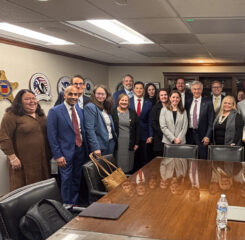What’s the Economic Benefit of Workforce Investments?
What’s the economic benefit of investing in the direct care workforce?
A new LeadingAge study will attempt to answer that question by exploring how increased compensation for direct care workers could favorably impact the national economy, the field of long-term services and supports (LTSS), and individual direct care workers.
“We were looking for a big and bold initiative that would change the conversation about the workforce crisis facing our field,” says LeadingAge President and CEO Katie Smith Sloan. “We’ve already made a strong emotional argument that we don’t have enough caregivers to care for our parents, our grandparents, and other loved ones. Now, we want to add a strong, economic argument for workforce investments that will capture people’s attention in a very different way.”
Two Boston-based researchers with distinguished backgrounds in the economics of aging will conduct the study. Dr. Christian Weller, a professor in the Department of Public Policy and Public Affairs at UMass Boston, is a former senior economist at the Center for American Progress, where he is currently a senior fellow. Dr. Beth A. Almeida, a nationally recognized expert on retirement, aging, and workforce policy issues, has held positions with the American Institutes for Research and the National Institute on Retirement Security.
Focusing on 3 Areas of Economic Impact
Weller and Almeida will study 3 specific areas in which investments in the direct care workforce could have a beneficial impact on the economy. Their final report, expected to be completed this summer, will explore how providing higher pay and more stable incomes for direct care workers could affect:
The overall economy: Researchers will study the existing minimum wage literature to determine how the national economy is likely to benefit as direct care workers with rising incomes increase their spending.
The LTSS field: The study will explore how higher pay and more stable incomes can reduce turnover in the LTSS field, and how these turnover reductions could lower hiring costs, offer savings to payers, and produce increases in productivity.
Individual workers: Finally, Weller and Almeida will explore how workforce investments can reduce the risk of poverty among direct care workers and lessen their dependence on public assistance programs.
Using the Report
LeadingAge hopes to use the study’s final report to raise awareness about the economic importance of the LTSS workforce. A primary audience for the report will be policy makers who are in a position to develop and support federal and state initiatives that could strengthen the direct care workforce.
Future research may explore economic impacts associated with investing in other segments of the LTSS workforce, including nurses, says Sloan. In addition, the hope is that state partners and members could apply LeadingAge’s measurement approach to help them gauge the economic impact of workforce investments in their states and communities.
“I view this as a step back to see the bigger picture on workforce, and a step up from the workforce initiatives we’re now spearheading,” says Sloan. “We will continue our current, and important, work to offer members tangible strategies they can use immediately to recruit and retain workers. But, at the same time, we’ll be taking a more global look at overarching workforce issues so we can address our long-term workforce challenges.”
The LeadingAge LTSS Center @UMass Boston will be managing the research project for LeadingAge.
“As applied researchers, we’d like to use the data to start advocating for improvements for direct care workers, particularly on the compensation side,” says LTSS Center Co-Director Robyn Stone, who is also senior vice president of research at LeadingAge. “But we also want to tie the data to our other advocacy efforts, including our work to gain support for better training and other strategies that will help us create a professional career for direct care workers that is valued and meaningful.”

Most Recommended
October 15, 2025
 Shutdown Week Three: Impact of Ongoing Closure on Affordable Housing
Shutdown Week Three: Impact of Ongoing Closure on Affordable Housing
December 10, 2025
Fiscal Year (FY) Funding 2026
October 07, 2025
Immigrant Workforce Matching Program Brings Workforce Relief
Recently Added
January 12, 2026
 LeadingAge Joins CMS' Oz in Hospice, Home Health Fraud Roundtables
LeadingAge Joins CMS' Oz in Hospice, Home Health Fraud Roundtables
January 12, 2026



